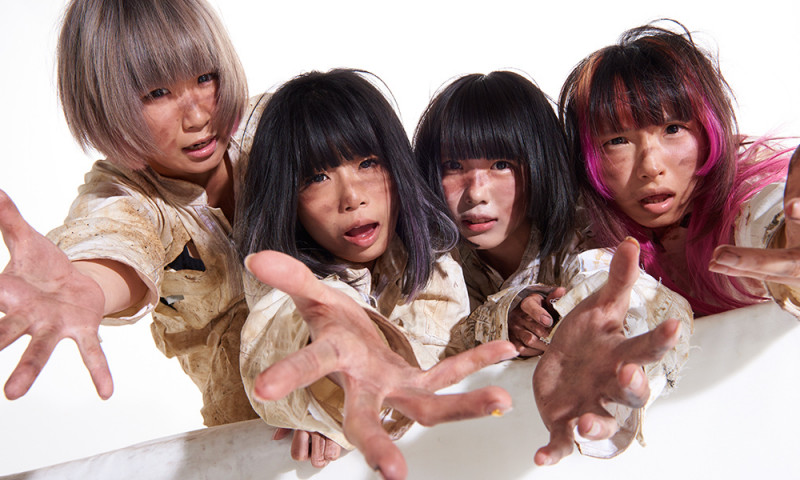
2nd Wave of Performers for Gyu-No Fes Spring Special Shin-Kiba Coast!
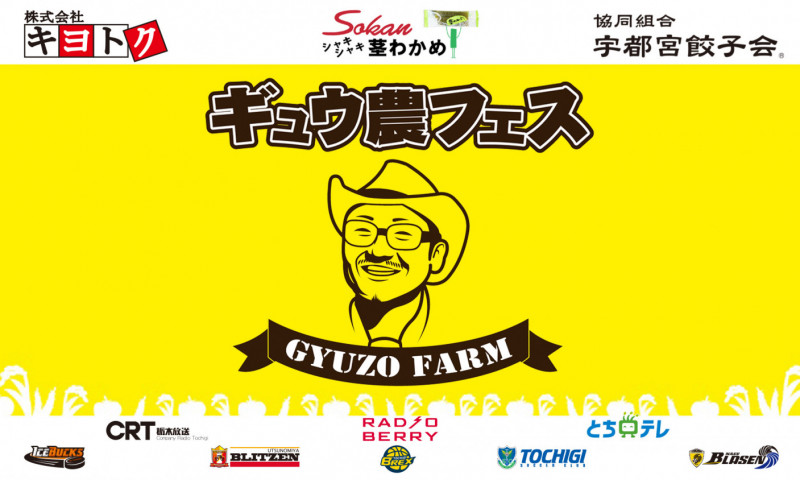
CHEERZ, the app for cheering on your favorite idols, isn’t just limited to Japanese, and is available in English and Chinese (Traditional), as well as French, and is used by idol fans around the world. As part of a campaign, every month at TGU, we interview CHEERZ’s monthly ranked top three girls.
アイドル応援アプリ、CHEERZ。日本語だけでなく英語、中国語(繁体字)、フランス語にも対応していて、世界中のアイドルファンに使われているアプリです。TGUではキャンペーンで上位に入った3名に、毎月インタビューを行っています。
This month’s guests are Kokoro Shinozaki from –petit pas!-, Kotone Asakawa from Nazotoki RPG Idol Last Question, and Mizuki Ueno from choco’to Cacao%. This time we’ll be talking to each of them about their participation in the annual Setsubun bean-throwing event at Kanda Shrine with the other members of their groups!
今月のゲストはプティパ –petit pas! –の篠崎こころさん、謎解きRPGアイドル・ラストクエスチョンの浅川琴音さん、choco’to カカオ%の上野瑞季さんの3名です。今回はこの3人がそれぞれのグループのメンバーと共に、神田明神で毎年恒例の大イベント、節分の豆まきに参加してきました!
Speaking of Kanda Shine, it’s the place where the AKB group’s Coming-of-Age-Day ceremonies are held, and is known as the “idol holy land”. Additionally, each year on February 3rd the Setsubun Festival Bean-Throwing Ceremony is held there, and is considered a special event, often said to be the gateway to success for idols on the verge of getting their big break, featuring top shining idols, like PASSPO☆ in 2011 and AKB48 back in 2009.
神田明神と言えば、毎年AKBグループの成人式が行われ、アイドルの聖地として知られている場所。さらに、毎年2月3日に開催される、「節分祭豆まき式 」は2009年には「AKB48」、2011年には「PASSPO☆」など、今を煌めくアイドルが出演するなど、ブレイク寸前アイドルの登竜門とも言われる特別な行事となっております。
According to the calendar, February 3rd marks the last day of winter, or Setsubun, and throwing beans on this day has become a traditional Japanese custom. Even a surprising number of Japanese are unsure of Setsubun’s roots. So what were our three idols able to learn about this unique Japanese cultural event? Our idols, who are sure to become future representatives of Japan, interviewed Mr. Kishikawa, the representative of Kanda Shrine Public Relations, and through their exchange about Setsubun we learned a lot!
暦の上では冬の最後の日とされている2月3日の節分の日には、豆を撒くことが日本の伝統習慣となっています。日本人でも意外と知らない、節分のルーツやその意味。3人はこの日本独特の文化行事についてどのようなことを学んだのでしょうか? 今後日本を代表するアイドルになるべく、神田明神広報の岸川さんにお話を伺いつつ、節分について実践を交えながら勉強して来ました!
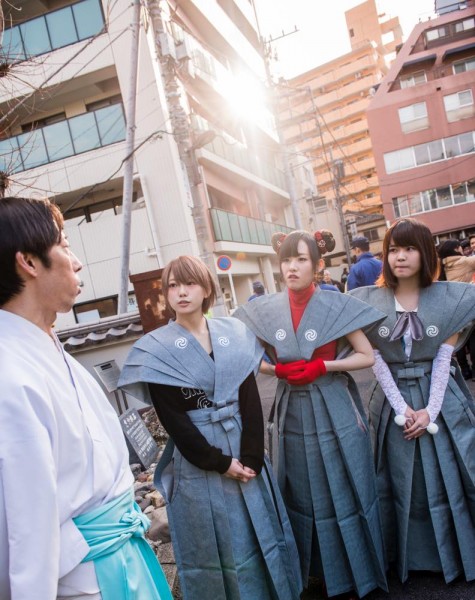
From right to left : Mizuki Ueno, Kotone Asakawa, Kokoro Shinozaki, and Kishikawa-san
Everyone: Thank you for having us.
全員:本日はよろしくお願いします。
Kokoro: Thank you for letting me take part in the bean-throwing at Kanda Shrine, or this year’s CHEERZ bean-throwing event. I’d like to know more about Japanese culture, so I hope you’ll let me ask you some questions about Setsubun.
篠崎:今回CHEERZの豆まきイベントということで神田明神の豆まきに参加させて頂いてありがとうございました! 日本文化についてもっと詳しく知りたいので、節分について色々質問させて下さい。
Mr. Kishikawa: Sure, it would be my pleasure.
岸川:はい。宜しくお願いします。
Kokoro: First of all, why does Setsubun (the end of winter) take place on February 3rd?
篠崎:そもそも、なんで2月3日が節分なんですか?

Mr. Kishikawa: Actually, February 3rd is the day before Setsubun. It carries the meaning of welcoming spring after it has passed. So there are seasonal festivals in all the four seasons, but among these for some reason, historically there used to be a festival on Setsubun for casting out misfortune, where people would eagerly throw beans while saying, “Good luck in, demons out!”
岸川:2月3日っていうのは、本当は節分の前日なんですよ。節分が過ぎたら、今度は春を迎えるという意味を持っているんです。だから春夏秋冬、どれにも節句はあるんですけど、その中でも、どういうわけか、節分では歴史的にこのようににぎやかに豆を撒いて「福は内、鬼は外!」って言って、厄を払って良いものを手に入れよう、っていうお祭りが行われるようになったんですね。
Kotone: Around when did this custom begin?
浅川 : それはいつごろから始まった風習なんですか?
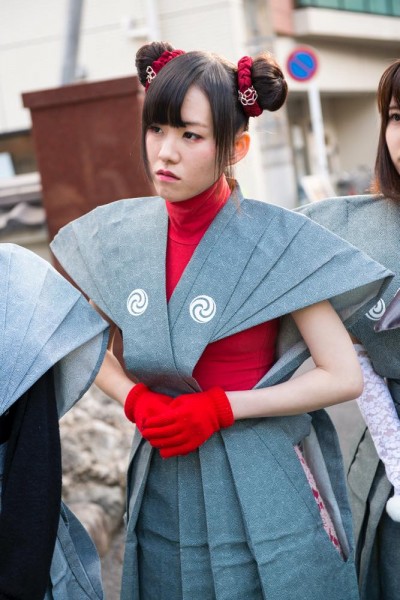
Mr. Kishikawa: It’s an ancient one that goes way back. Originally the Imperial family would go around saying “Setsubun ya”, and once the Emperor started a festival for it, common people began celebrating it as well.
岸川 : 古代、昔からですね。元々は「節分や」っていって皇室、天皇陛下が始めたお祭りから一般の人もやるようになったんですね。
Kotone: Why do people throw beans?
浅川 : なぜ撒くものが豆になったんでしょうか?
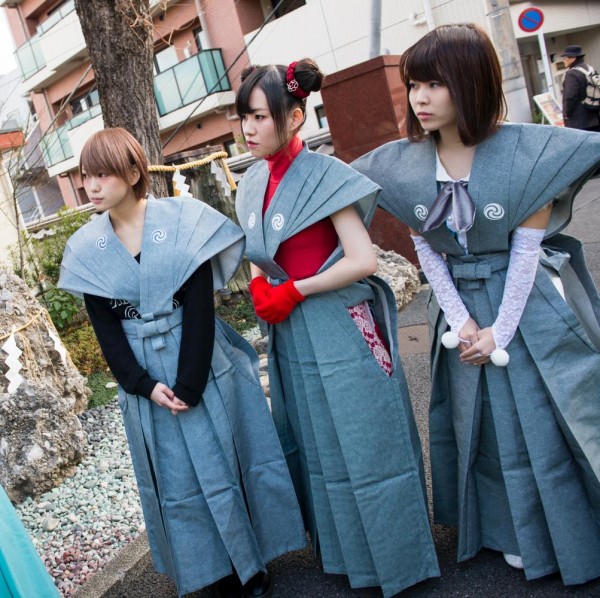
Mr. Kishikawa: One reason was to get rid of the demons by throwing them, but it seems another reason was in order to give an offering to the gods of the earth. Long ago people would throw offerings to the gods of the earth. So, the same with Setsubun beans, they were also given as an offering to these gods. But between the two, it would seem the main meaning has become to ward off demons.
岸川: ひとつは豆を撒いて鬼を退治するっていう意味があるのと、もう一つは、地面にも神様がいてその神様にお供え物をする、という意味もあるらしいです。お賽銭も、かつては、地面にいる神様に向けて投げたりしてたんですよ。なので、節分の豆も、地面にいる神様にお供え物として差し上げてた、という意味があるんですね。でも今はどちらかというと、豆を投げて鬼をやっつける、という意味合いがメインになっていますね。
Kotone: So the beans are to hit them with!
浅川:鬼に豆をぶつける、みたいな感じですよね!
Mr. Kishikawa: That’s right. However the demons are also originally gods, so while they’re mean to hit them, they’re also an offering like I mentioned before.
岸川 : そうそう。ただ鬼もそもそも神様なんで、ぶつけるっていう意味もあるんですけど、お供え物っていう意味も実はあるんです。さっき言った様に。
Mizuki: That makes sense! Do you have any pointers on the correct way to throw the beans?
上野 : そうなんですね! 豆の正しい投げ方とかコツってあるんですか?
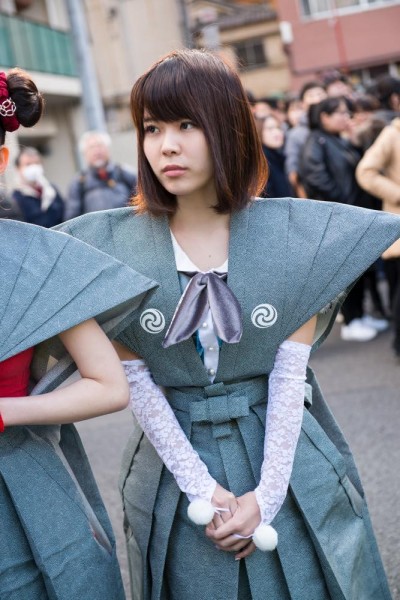
Mr. Kishikawa: Well, there’s not a particular correct way, but at the Kanda Shrine we throw sweets along with beans. (laugh) So I think you should aim to throw them out to everyone as much as possible.
岸川:そうですね、特にそういうのはないんですけど、神田明神の節分では豆の他にお菓子とかも投げてるんで(笑)。だから、なるべくみんなにいきわたるように投げてあげるのがいいと思いますね。
Kotone: There’s more freedom to it than I’d originally thought! (laugh) I’ve heard that the phrase “Demons out, good luck in!” differs depending on region, but is that true?
浅川 : 意外と自由でいいんですね(笑)!「鬼は外、福は内」っていう言葉も、地方によっても違うという話を聞いたことがあるんですけど、本当ですか?
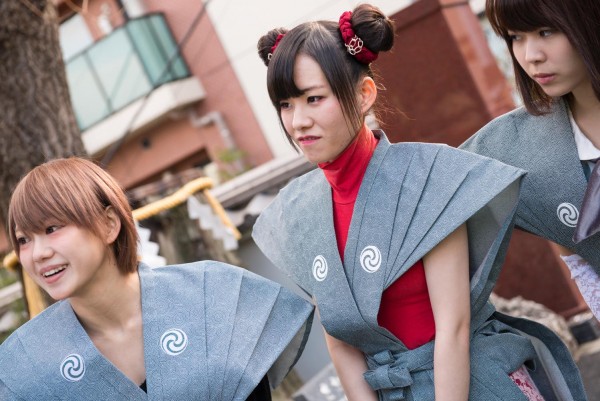
Mr. Kishikawa: That’s right, there are places that don’t say “demons out”, as well as ones that don’t say “good luck in”, too; it really depends. (laugh)
岸川 :そうですね、「鬼は外」って言わないところもありますし、逆に「福は内」っていうのを言わないところもありますし、結構バラバラですね(笑)。
Kotone: Is there a particular meaning behind people born in the same (Chinese) zodiac year throwing beans? (For example, 2016 is the year of the monkey, so people born in other monkey years like 2004, 1992, 1980, etc.)
浅川 : 年女とか年男の人たちが豆を撒く、っていうことにも意味があったりするんですか?
Mr. Kishikawa: Yes, there’s a purification meaning behind it. Once you reach a certain age, you get tired from a number of things, right? (laugh) So part of the exorcism is purifying yourself as you throw the beans.
岸川 : そうです、お祓いの意味がありますね。厄落としっていうのがあって、ある年齢になったら、ちょっと色々疲れたりするじゃないですか(笑)、それを豆を撒くことによってお祓いをするんです。
Kokoro: I see, so the beans have the power of purification.
篠崎:なるほど、やっぱり豆はお祓いの力もある、と。
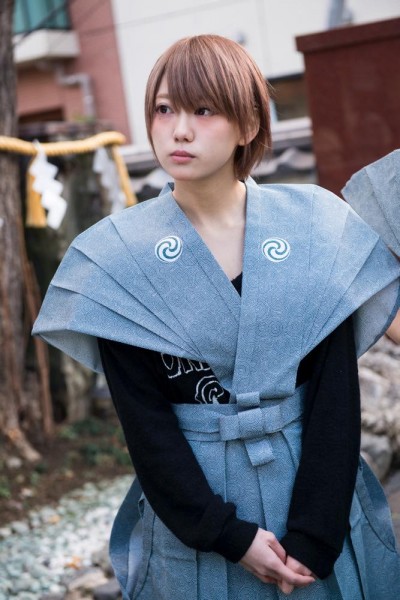
Mr. Kishikawa: I believe so, yes.
岸川 : あると思いますね、はい。
Kokoro: Speaking of which, I’ve heard that you should eat the same number of beans as your age on Setsbun, but is this true?
篠崎 : そういえば節分には、自分の年の数だけ豆を食べるといい、って昔聞いたことがあるんですけど、本当ですか?
Mr. Kishikawa: Well, there are a lot of traditions that have been handed down, but I think it’s a good thing to do now.
岸川 :そうですね、色んな言い伝えはありますけども、今はそうやって食べたほうがいいと思いますね。
Mizuki: Just a little before we drank some sake (rice wine), but is there any meaning to drinking it on Setsubun?
上野: さっきお酒を飲んだんですけど、節分にお酒を飲むっていうものも、意味があるんですか?
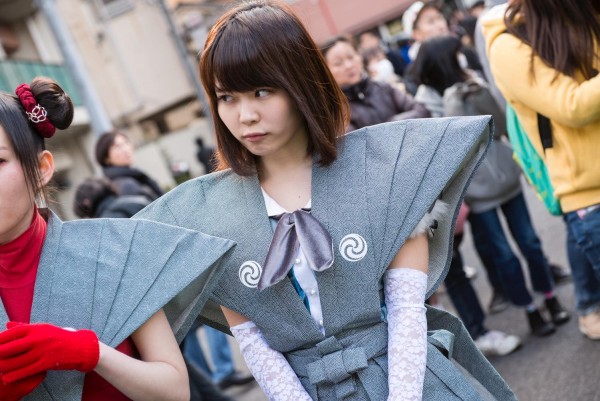
Mr. Kishikawa: Drinking sake is to receive the power of the gods. Also you become cleansed.
岸川 : お酒を飲んで、神様の力をもらうっていう意味がありますね。あとは清めにもなるんで。
Kotone: Are the things people throw different depending on their region? I was a little surprised to hear about sweets being thrown. (laugh)
浅川 : 投げるものって、地域によって違ったりするんですか? お菓子はちょっとびっくりしました(笑)。
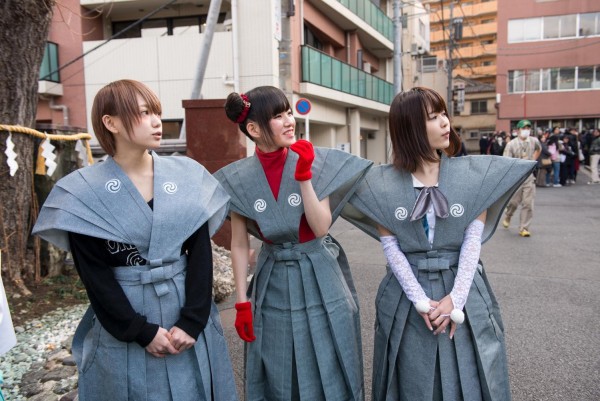
Mr. Kishikawa: They are. There are places that really just throw beans, but at the Kanda Shrine, although Setsubun is part of Shinto rituals, we also feel people should enjoy it, so by throwing sweets it’s kind of like a lottery… And I think something fun like that is good for the shrine.
岸川 : 違いますね。本当に豆を撒くところもありますけど、神田明神では、節分は神事ではあるんですけども、みんなにも楽しんでもらいたいっていう想いもあるので、お菓子を投げて、そこに福引きがついていたり……そういう楽しみも、神社にはあっていいと思うんです。
Kotone: That’s interesting. About how many people visit each year?
浅川 : 面白いですね。年間どれぐらいの人が毎年いらっしゃるんですか?
Mr. Kishikawa: We never really count how many people visit each year, but during the first three days of the new year around 300,000 people come to pray.
岸川:年間は数えたことないですけど、正月の三が日で、大体30万人ぐらいの人がお参りに来ます。
Kotone: Does that number include overseas visitors, too?
浅川:その中には海外の人たちはいたりとかもするんですか?
Mr. Kishikawa: Yes, there are quite a lot. Today there were overseas travellers that visited here and there, too. Because Akihabara is so close, we get quite a few visitors from a number of countries.
岸川:いますね、結構。今日も海外旅行で来てる人がちらほら。秋葉原が近いから、結構いろんな国の方がいらっしゃいますね。
Kotone: Just before there were some foreigners on the shrine path that were saying “Love Live! Love Live!” as they walked.
浅川:さっきも参道の所にいらっしゃった外国の方が、「ラブライブ!ラブライブ!」って言いながら歩いてました。
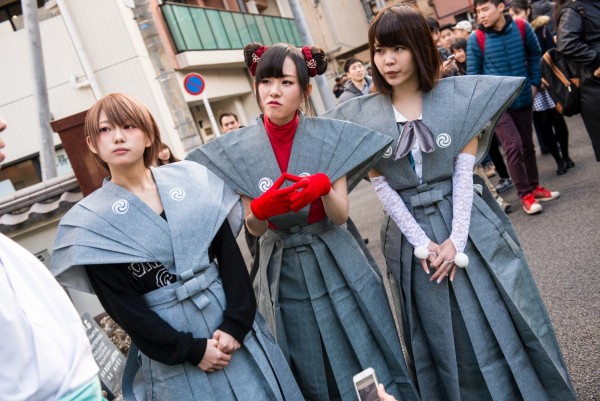
Mr. Kishikawa: Yes, the Kanda Shrine is collaborating with Love Live! Thanks to that, there have been many visitors.
岸川:そうそう、神田明神はラブライブ!と神田祭でコラボしてるんです。そのおかげもあって、たくさんの人が来てくれます。
Kokoro: It’s easy for a lot of people to come by with a non-so-strict, “everyone have fun” kind of atmosphere.
篠崎 : あんまりかたくとらわれないで「みんなで楽しもう」みたいな空気が、入りやすくていいですね。
Mr. Kishikawa: Shrines are a place where you go to pray, so of course there is a sacred meaning to it, but originally they were tourist destinations. In the past they had shooting ranges, too. So I think it’s better if shrines are places where people can enjoy themselves. Because of that, Kanda Shrine is doing collaborations like this one.
岸川 : 神社ってお参りする場所でもちろん神聖な意味合いもあるんですけど、もともと観光地でもあるんですよ。昔は射的場とかもあったんです。だから、神社ってそういう楽しみがある場であってもいいと思うんで。なので神田明神はこういうコラボをしたりしています。
Everyone: Thank you for such a valuable discussion!
全員:貴重なお話ありがとうございました!
Following the bean-throwing event, we had a luxurious Setsubun (winter’s end) meal. Since the mean contained many dishes not normally eaten, everyone was very excited!
豆まきイベントの後には、会館の地下にて豪華な節分のお食事も頂きました。普段なかなか食べないものばかりで、みんな興味津々!
Our three idols surprisingly learned a lot about Setsubun’s roots, how the shrine was originally a place for enjoyment, and so on. By knowing more about their country, hopefully they’ll be able to draw upon their knowledge of Japan during their activities overseas!
節分のルーツ以外にも、神社がもともと娯楽を楽しむ場所でもあった事など、意外なことを学んだ3人。自分の国の事をもっと知り、海外へ向けての活動で知識が生かせるといいですね!
It’s worth noting that although the Setsubun event is only held on February 3rd, you can still visit Kanda Shrine any time during the year. If you come to Japan we hope you’ll enjoy making a visit there.
なお、節分のイベントは毎年2月3日のみの開催となりますが、神田明神は年中無休で訪れる事ができます。日本に来た際はぜひ遊びに行ってみて下さい。
Related links
–petit pas!- official site : http://petitpas.mave-ricks.com/
Kokoro Shinozaki Twitter : https://twitter.com/kokoro777pp
Last Question official site : http://lab-question.jp/
Kotone Asakawa Twitter : https://twitter.com/enotok_a
choco’to Cacao% official site : http://www.wip-idol.com/
Mizuki Ueno Twitter : https://twitter.com/chococaca_mikki
CHEERZ official site : https://cheerz.cz/
Photos by Nathan Gey
Translated by Jamie Koide



